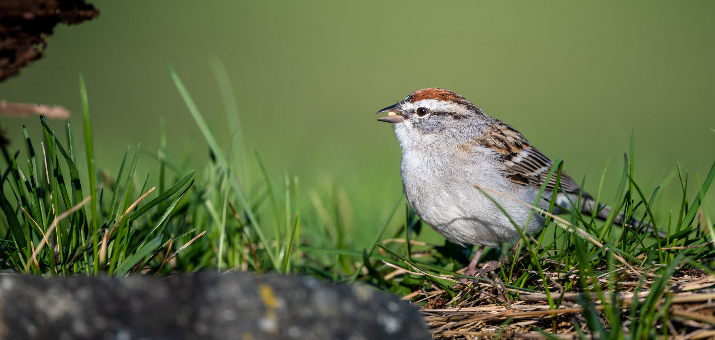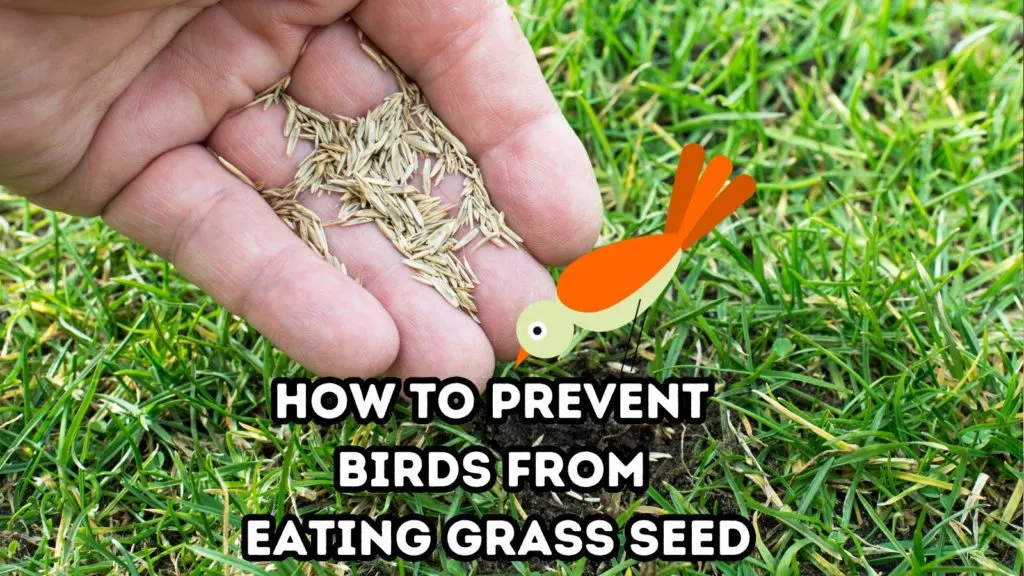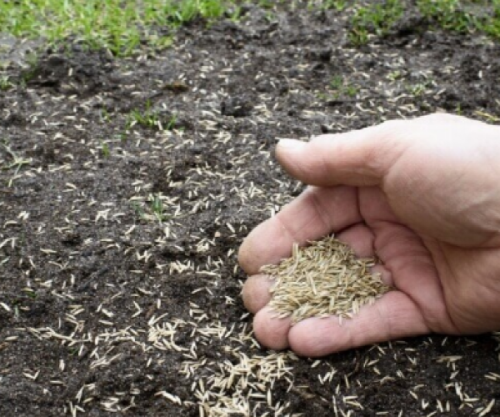Keeping birds away from your grass seed can be challenging. Birds love to snack on freshly sown seeds, ruining your efforts.
To ensure your grass grows lush and green, you need effective strategies to deter these feathered intruders. Many people struggle with this issue, but there are simple solutions. In this guide, we’ll explore practical methods to protect your grass seed from birds.
Whether you’re a seasoned gardener or just starting, these tips will help you safeguard your lawn and achieve great results. So, let’s dive in and learn how to keep those pesky birds away from your precious grass seed!
Importance Of Protecting Grass Seed
Protecting grass seed is vital to ensure a lush, green lawn. Covering seeds with a light layer of straw or netting helps keep birds away. Simple barriers can make a big difference.
Planting grass seed is a significant investment for any lawn. Grass seeds are vulnerable, especially in the initial stages. Birds can quickly consume the seeds, leaving your lawn bare. Protecting the grass seed ensures a lush, green yard. It also saves time and money spent on re-seeding.Impact Of Birds On Grass Growth
Birds love grass seed. They see it as an easy meal. When birds eat the seeds, they reduce the chances of germination. This affects the overall growth of the grass. Sparse grass means a patchy and unattractive lawn. Additionally, bare spots can lead to erosion and weed growth. These issues make it vital to keep birds away.Benefits Of Bird Deterrence
Deterring birds has many benefits. First, it increases the chances of seed germination. This leads to a denser, more vibrant lawn. A full lawn is more resistant to weeds and erosion. It also enhances the overall appearance of your yard. By keeping birds away, you protect your investment and ensure a beautiful outdoor space. “`
Credit: swellseedco.com
Choosing The Right Time To Seed
Choosing the right time to seed your lawn is crucial to ensuring the grass grows strong and healthy. Timing also plays a significant role in keeping birds from feasting on your precious grass seeds. Let’s dive into how optimal seasons and weather considerations can make a difference.
Optimal Seasons For Seeding
The best seasons for seeding your lawn are typically fall and spring. During these times, temperatures are ideal for grass growth. Cooler weather helps the seeds settle into the soil.
In fall, the soil is still warm from summer, allowing seeds to germinate quickly. Plus, you’ll face fewer weeds competing with your grass. Spring offers similar benefits but comes with more unpredictable weather.
Have you ever planted seeds in the summer? It’s tough to keep birds away when grass seeds are exposed. Choose your seasons wisely to save time and effort.
Weather Considerations
Weather plays a big role in the success of seeding. Aim to plant seeds when the forecast predicts mild temperatures and occasional rain. Steady moisture helps seeds germinate and reduces the chance of birds spotting them.
Too much rain can wash away seeds, while drought conditions can make it hard for them to grow. Monitor weather patterns closely before deciding to seed your lawn.
Imagine seeding your lawn only to have birds swoop in after a heavy rain washes seeds away. Timing it right can prevent such setbacks.
Would you prefer dealing with fewer birds by seeding in the fall or spring? Choosing the right time not only supports your grass but also makes your seeding efforts worthwhile.
Using Physical Barriers
Using physical barriers is an effective way to keep birds out of grass seed. Birds can easily spot freshly seeded areas and may decide to feast on them. Physical barriers can prevent this problem and ensure your grass seed remains untouched.
Netting And Mesh Solutions
Netting and mesh solutions can be highly effective in protecting grass seed from birds. These materials are easy to install. They cover the seeded area without causing harm to birds. You can purchase bird netting at garden stores. Simply stretch it over the seeded area and secure it with stakes. Ensure the netting is taut. This prevents birds from getting trapped or tangled.
Protective Covers And Tarps
Protective covers and tarps can also keep birds away from grass seed. They provide a solid barrier that birds cannot penetrate. Use lightweight tarps that allow sunlight and water to reach the soil. Secure the edges with rocks or stakes. This keeps the tarp in place and protects the seed. Remove the tarps once the grass starts to grow. This allows air circulation and avoids damaging the young plants.
Natural Repellents
Keeping birds out of your grass seed can be challenging. Natural repellents offer an eco-friendly way to protect your lawn. These methods are safe for pets and kids. Let’s explore some natural options.
Homemade Repellent Recipes
You can make effective bird repellents at home. One simple recipe uses chili peppers. Mix chopped chili peppers with water. Boil the mixture and let it cool. Spray it on the grass seed. Birds dislike the strong smell and taste.
Another recipe involves vinegar. Mix vinegar with water in a spray bottle. Adding garlic can boost its effectiveness. Spray this mixture around the seeded area. Birds will stay away from the strong scent.
Plants That Deter Birds
Certain plants can naturally repel birds. Marigolds are one of them. Their strong smell keeps birds at bay. Plant marigolds around your lawn. They also add color to your garden.
Lavender is another great option. Birds dislike its strong fragrance. Planting lavender around your grass seed can be very effective. It also attracts beneficial insects.
Using natural repellents is an effective way to keep birds away. These methods are safe and easy to implement.
Visual Deterrents
Birds can be a real nuisance when it comes to keeping grass seed safe. Visual deterrents can be highly effective in discouraging birds from feasting on your freshly sown grass. They rely on sight to find food. This makes visual deterrents a practical solution.
Reflective Objects
Reflective objects can scare birds away. Their shiny surfaces create flashes of light that confuse and startle birds. Hang old CDs or aluminum foil strips around your yard. They move with the wind, creating unpredictable light patterns. This makes birds uneasy and discourages them from landing.
Mylar balloons also work well. Their reflective surfaces and movement are very effective. Hang them on stakes near the seeded area. These simple items can protect your grass seed from hungry birds.
Decoy Predators
Decoy predators can also be very effective. Fake owls or hawks can scare smaller birds away. Place these decoys in visible spots around your yard. Move them every few days to keep birds from getting used to them.
Adding a decoy snake can also work. Birds are naturally afraid of snakes. Place rubber snakes in the grass to deter them. This simple trick can save your grass seed.

Credit: www.birdtipper.com
Sound-based Deterrents
Keeping birds away from your freshly seeded grass can be a challenge. Birds love seeds and can quickly ruin your efforts. One effective method to deter them is using sound-based deterrents. These tools create noises that make birds uncomfortable, prompting them to leave your lawn alone.
Ultrasonic Devices
Ultrasonic devices emit high-frequency sounds that are unpleasant to birds but usually inaudible to humans. You can place these devices around your lawn to create a bird-free zone. They are often solar-powered, so you don’t have to worry about constantly replacing batteries.
My neighbor tried one of these devices last spring. His lawn thrived while ours was picked clean by birds. That convinced me to try it out, and the results were impressive. The birds stayed away, and our grass grew lush and green.
Before buying, make sure to check the range of the device. Some cover larger areas than others. Also, consider the local bird species. Some birds might be more stubborn and less affected by ultrasonic sounds.
Noise-making Tools
Another effective method involves noise-making tools like wind chimes or motion-activated noise makers. These tools create sudden sounds that startle birds and keep them from settling in. Simple items like aluminum foil strips can also reflect light and make noise in the wind.
Once, I used a combination of wind chimes and old CDs hanging from strings. The constant movement and noise kept the birds away from our grass seed. It was a simple yet effective solution.
You can get creative with noise-making tools. Experiment with different items to see what works best in your yard. A proactive approach will keep the birds guessing and your grass safe.
Have you tried any sound-based deterrents? What worked best for you? Share your experiences in the comments!
Chemical Repellents
Chemical repellents can deter birds from eating grass seed effectively. These products create an unpleasant taste or smell, keeping birds away from newly sown areas. Proper application ensures your grass seed remains undisturbed.
Keeping birds away from your grass seed can be challenging. Chemical repellents can help protect your investment in your lawn. These repellents deter birds without harming them. They are a practical solution for those who are tired of seeing their grass seed disappear.Safe Chemicals For Birds
Chemical repellents are designed to be safe for birds. This means they won’t harm or kill them. Instead, they create an environment that’s unpleasant for birds, encouraging them to leave. Some popular options include methyl anthranilate and capsaicin. Methyl anthranilate is a grape flavoring used in food products. Birds find it irritating, making them avoid treated areas. Capsaicin, the compound that makes chili peppers hot, works similarly. It’s safe for birds but makes them uncomfortable.Application Techniques
Proper application is key to effectiveness. You need to cover the entire area where you’ve spread grass seed. Using a spray bottle can ensure even distribution. For larger areas, consider a garden sprayer. This will make the process faster and more efficient. Remember to reapply after rain or heavy watering. Some people mix the repellent with water before spraying. This can stretch the product further. Make sure to follow the manufacturer’s instructions for best results. Have you tried using chemical repellents before? What was your experience? Share your thoughts in the comments!
Credit: www.georgedaviesturf.co.uk
Regular Monitoring And Maintenance
Keeping birds out of grass seed requires regular monitoring and maintenance. Birds are persistent and can easily find ways to get to the seeds. Regular checks and adjustments will help keep your grass seed safe and ensure it grows well.
Inspecting The Area
Inspect the seeded area often. Look for signs of birds or damage. Check if any seeds are missing. Birds leave tracks and droppings, which are clear indicators. Regular inspection helps you catch problems early. This way, you can act before birds eat too many seeds.
Adjusting Strategies As Needed
If you notice birds still getting to the seeds, adjust your strategies. Consider adding more deterrents or changing their placement. You might need to use different methods to keep the birds away. Each area is unique, so be flexible with your approach. Regularly update your methods to stay ahead of the birds.
Frequently Asked Questions
How Do I Keep Birds Off My Newly Seeded Lawn?
Use bird netting or scarecrows to deter birds. Lay down straw mulch to cover seeds. Install reflective tape or spinning pinwheels.
What’s The Best Thing To Cover Grass Seed With?
The best thing to cover grass seed with is a thin layer of straw or compost. This helps retain moisture and protects seeds from birds.
How Do You Protect Seeds From Birds?
Cover seeds with netting or mesh. Use reflective objects like CDs to scare birds. Apply bird repellent sprays. Plant decoy seeds. Utilize garden row covers.
How To Plant Seeds Without Birds Eating Them?
Cover seeds with fine mesh or netting. Plant seeds deeper in the soil. Use bird repellent or scare devices.
Conclusion
Keeping birds out of your grass seed ensures a lush, green lawn. Use simple techniques like netting, decoys, and scare tactics. Consistency is key. Check the area regularly. Reapply methods as needed. Protecting your grass seed saves time and effort.
Enjoy a beautiful, bird-free lawn. Happy gardening!
